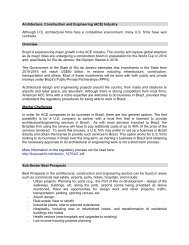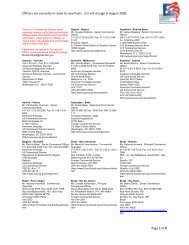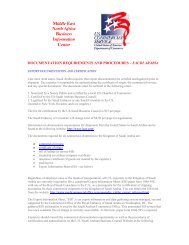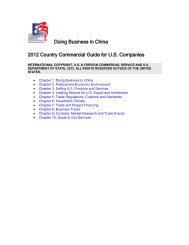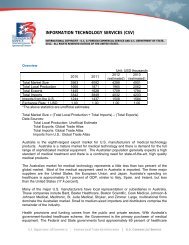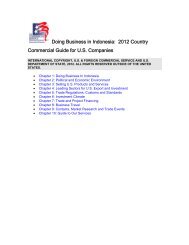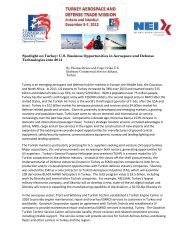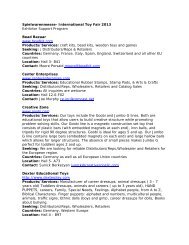Healthcare Technologies Resource Guide - Export.gov
Healthcare Technologies Resource Guide - Export.gov
Healthcare Technologies Resource Guide - Export.gov
Create successful ePaper yourself
Turn your PDF publications into a flip-book with our unique Google optimized e-Paper software.
Medical devices in the French market, whether\ for imported products or domestically manufactured<br />
lines, are subject to the following requirements:<br />
• Medical devices have to obtain the CE mark.<br />
• Medical devices have to have Directions for use enclosed in the French.<br />
Current Market Trends<br />
The medical market is likely to see moderate growth, rising from USD 6.784 billion in 2012 to USD 7.8<br />
billion by 2017. Foreign companies are prominent in the domestic medical manufacturing industry,<br />
with larger manufacturers operating as subsidiaries of multinational groups. With flagging domestic<br />
production in several sectors the French medical device market is increasingly reliant upon imports,<br />
which now account for around 50% of consumption.<br />
Main Competitors<br />
France is home to many subsidiaries of American companies such as Alcon, 3M, Baxter, Johnson &<br />
Johnson medical, Medtronic, Boston Scientific, Cyberonics and St. Jude Medical.<br />
Current Demand<br />
• Diagnosis: The diagnostic sub-sector represents 35 percent of the total medical equipment market.<br />
State-of-the-art diagnostic medical imaging systems are in great demand. Applications for this<br />
technology already exist for pediatrics, cardio-vascular care, digestion, urology, and spinal/nerve<br />
treatment. As it is well accepted and effective, the demand for this type of technology will continue<br />
to grow. Health care professionals are very optimistic about a feature of medical imagery equipment<br />
known as "image networking." This will dramatically improve diagnostics by providing an image data<br />
bank that would enable a specialist to compare the image of a current case to hundreds of previous<br />
cases.<br />
• Rehabilitation: This sub-sector represents 26 percent of the total medical equipment market. It<br />
includes all types of disposable medical products. The increasing elderly population reinforces the<br />
demand for all kinds of disposable equipment and supplies such as incontinence products and care<br />
kits used by nurses and families for home-care.<br />
• Surgery: The surgery instrument and supplies sub-sectors represent approximately 17 percent of<br />
the total sector. Recent developments in the non-invasive surgery field could have a strong impact<br />
on everyday hospital practice. These latest advances offer superior results and also present a<br />
significantly reduced risk to patients.<br />
• Technical aids: The French market for medical prosthesis, 8 percent of the total medical equipment<br />
market, is characterized by a strong potential for innovative internal prosthesis such as knees, hips,<br />
ligaments, and elbows, and with a slightly decreasing market for external prosthesis. Technological<br />
evolution, especially in the field of anesthesia, offers the potential for rapid changes in this market.<br />
• Intensive care: Intensive care equipment such as respiratory monitoring, pumps and incubators<br />
represent about 8 percent of the total medical equipment market. Intensive care equipment includes<br />
the latest technological advances. Both public and private hospitals show a rising demand for<br />
intensive care equipment and supplies.<br />
• Hygiene: The hygiene sub-sector represents approximately 6 percent of the total medical<br />
equipment sector. Patient and medical personnel safety is of growing concern to members of the<br />
medical profession and the public. Best sales prospects will certainly focus around assuring stringent<br />
personnel safety requirements. This is especially due to the requirements considering the current<br />
concerns regarding infectious diseases. In the future, prevention should receive similar emphasis<br />
considering the present focus on protection.<br />
Registration Process<br />
All medical devices sold in France have to carry the CE Mark. Registering with the French Ministry of<br />
Health is to be addressed on a case by case basis. In the very best interest of any U.S. exporter, and in the<br />
vast majority of cases, this task is handled by the importer/distributor.<br />
U.S. Commercial Service <strong>Healthcare</strong> <strong>Technologies</strong> <strong>Resource</strong> <strong>Guide</strong> | 2012–2013<br />
41





